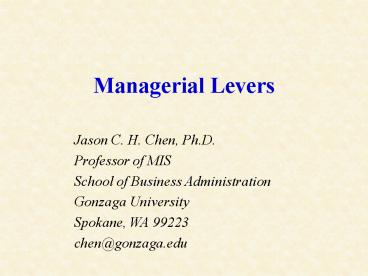Managerial Levers - PowerPoint PPT Presentation
1 / 16
Title:
Managerial Levers
Description:
Managerial Levers Jason C. H. Chen, Ph.D. Professor of MIS School of Business Administration Gonzaga University Spokane, WA 99223 chen_at_gonzaga.edu Information Ecology ... – PowerPoint PPT presentation
Number of Views:1310
Avg rating:3.0/5.0
Title: Managerial Levers
1
Managerial Levers
Jason C. H. Chen, Ph.D. Professor of MIS School
of Business Administration Gonzaga
University Spokane, WA 99223 chen_at_gonzaga.edu
2
Information Ecology (Davenport)
Data Simple Observations of the world Easily
structured Easily captured on machines Often
quantified Easily transferred
Information Data endowed with relevance
purpose Requires unit of analysis Need consensus
on the meaning Human mediation necessary
Knowledge Info. from the mind includes
reflection, context, synthesis Hard to
structure Difficult to capture on machines Often
tacit Hard to transfer
3
IS Strategy Triangle
Business Strategy
Where is the business going and why?
IT impact and potential
Organizational Strategy
IT Strategy
What is required?
How it can be delivered?
We will study the business strategy later.
N
4
Organizational strategy frameworks
Usefulness of IS Discussions
Key Idea
Business Diamond 4 key organizational components 1) business processes, 2) values and beliefs, 3) management control systems, and 4) tasks and structures. Using IS in an organization will affect each of these components. Use this framework to identify where these impacts are likely to occur.
Managerial Levers Organizational variables, control variables, and cultural variables are the levers managers can use to affect change in their organization. This is a more detailed model than the business diamond and gives specific areas where IS can be used to manage the organization and to change the organization.
Source Pearlson, 2001
5
The Business Diamond
Business Process
Jobs and Structure
Values and Beliefs
Management and Measurement Systems
(Source Hammer et al, 1994)
6
DAvenis Disruption and 7-Ss
7
DAvenis 7-Ss
Approach
Definition
Understanding how to maximize customer
satisfaction by adding value strategically
Superior stakeholder satisfaction
Seeking out new knowledge that can predict or
create new windows of opportunity
Strategic soothsaying
Positioning for speed
Preparing the organization to react as quickly as
possible
Preparing the organization to respond to the
marketplace in a manner that will surprise
competitors
Positioning for surprise
Finding new ways to serve customers which
transform the industry
Shifting the rules of competition
Signaling strategic intent
Communicating the intended actions of a company,
in order to stall responses by competitors
Simultaneous and sequential strategic thrusts
Taking a series of steps designed to stun and
confuse competitors in order to disrupt or block
their efforts
8
Managerial Levers Organizational Design
Variables
Organizational variables
Control variables
Cultural variables
9
Managerial Levers
Execution
Control
Organization
Culture
Source Cash, et al., 1994
10
Summary of Key Strategy Frameworks
Usefulness in Information Systems Discussions
Framework
Key Idea
Porters generic strategies framework
DAvenis hypercompetition model
Brandenberg and Nalebuffs co-operation model
11
Conventional and IT design variables
Conventional Design Variable
Class of Variable
IT Design Variable
Structure
Work process
Communications
Interorganizational
Source H. Lucsa and J. Baroudi, The Role of
Information Technology in Organization. JMIS,
Spring 1994, pp. 9-23
12
Functional (Hierarchical) View of the Firm
(source Pearlson, p.9, 2001)
13
NOLANs Six Stages of IS Growth
14
NOLANs Six Stages of IS Growth
The six stages are
1. Initiation Initial introduction of computers
to the organization. Batch processing to
automate clerical operations to achieve
cost reduction, operation systems focus,
lack of management interest, and Centralized ISD.
2. Contagion (expansion) Centralized rapid
growth as users demand more applications
based on high expectations of benefits,
move to online systems as ISD tries to
satisfy all user demands. Little control if any.
IT expenses increase rapidly.
3. Control In response to management concern
about cost vs. benefits, systems projects
are expected to show a return, plans are
produced and methodologies/standards
enforced. Often produces a backlog of
applications and dissatisfied users.
Planning and controls are introduced.
4. Integration Considerable expenditure on
integrating (via telecommunications and
databases) existing systems. Users
accountability for system established, and ISD
provides a service to users, not just
solutions to problems. At this time there
is a transition computer use and a approach from
data processing to information and knowledge
processing (transition between the two
curves).
5. Data administration information requirements
rather than processing drive the
applications portfolio and information is
shared within the organization. Database
capability is exploited as users understand
the value of information and are willing
to share it.
6. Maturity The planning and development of IT
in the organization is closely coordinated
with business development. Corporatewide
systems are in place. The ISD and the users
share accountability regarding the
application of computing resources. IT has truly
become a strategic partner.
Source Compiled from Nolan (1979).
15
NOLANs Six Stages of IS Growth (Cont.)
16
Critical Success Factors Questions
1. What objectives are central to your
organization?
2. What are the critical factors that are
essential to meeting these objectives?
3. What decisions or actions are key to these
critical factors?
4. What variables underlie these decisions, and
how are they measured?
5. What information systems can supply these
measures?
17
Value-Creating Business Opportunities
Commerce
Content
Community
Value-Enabling IT Infrastructure
Solutions and Services
- Enterprise resources planning
- Supply chain management
- Customer relationship management
- E-business packages
- Pedagogic systems (Blackboard systems)
- Internet service providers
- Systems integration services
- Outsourcing and hosting
Software Productivity and Development Tools
Security and Control
Innovation and Diffusion
- Productivity packages
- Integrated development environments (Jbuilder,
VB, CBuilder) - Programming languages (Java, C, VB, COBOL,
etc.) - Specialized software (simulation, statistical
analysis, groupware) - Web site development tools
- Streaming medium tools
Computing
Communication
- Hardware (computers, printers, etc.)
- Operating systems
- Database management Information
- Document management systems
- Application frameworks (J2EE, .NET, XML, etc.)
- Hardware (networks, routers, etc.)
- Network operating systems
- Gateways
- E-mail and file transfer services
- Servers Web, applications, and database
- Tele- Video-conferencing equipment
18
?????????
Source ABN.AMRO Asset Management Taiwan Ltd.































